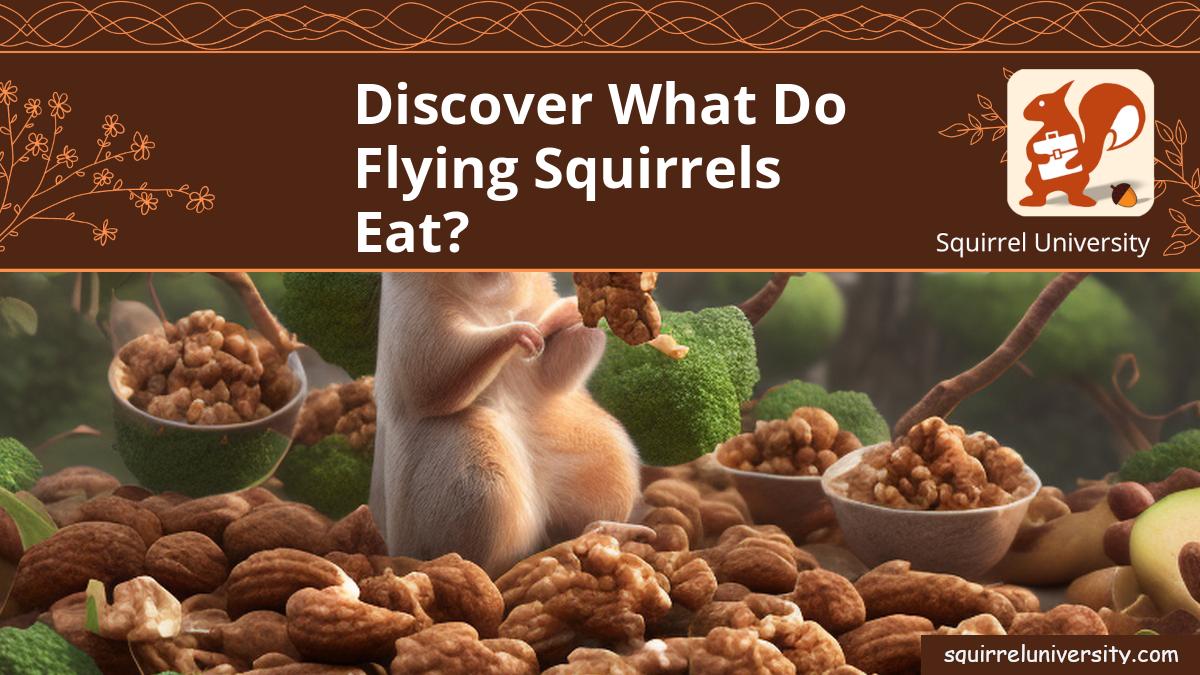As a nature lover and someone with many years of experience observing and interacting with flying squirrels all around the world, I can tell you that flying squirrels are delightfully curious creatures. You may have wondered what do flying squirrels eat? We know they are omnivorous so in this blog post, I’d like to share the best foods they enjoy eating!
Flying squirrels have a diverse diet that features various fruits, nuts, bugs, small birds and even pieces of meat. Around bird feeders, they will munch on sunflower seeds, peanuts, corn kernels and suet. Additionally, in certain areas these critters have been seen lapping up maple sap!
What Do Flying Squirrels Eat?
Overview of Diet
Flying squirrels are omnivores, meaning they eat both plant and animal food. Their diet consists of a variety of items including nuts, fruits, fungi, insects, eggs, small birds and carrion. The Southern flying squirrel is known to be the most carnivorous of all squirrel species since they will supplement their diet with scavenged or hunted eggs and birds.
At bird feeders, you may find flying squirrels munching on sunflower seeds, peanuts, corn kernels and suet. There are also reports that some flying squirrel populations consume maple sap in certain areas.
Nutritional Needs and Foods to Avoid
Given the wide range of foods that flying squirrels eat in nature, it can be challenging for pet owners to replicate this perfect balance for their pets. However, as long as there is a wide range of available foods from local natural sources supplemented with store-bought treats, your pet should receive adequate nutrition.
Some foods that should be avoided when feeding your pet flying squirrel include any high-fat or salty snacks such as chips, popcorn or pretzels; processed meats such as bacon; chocolate; dried fruit; and any sugary treats like candy or cookies.
Healthy Diet for Pet Flying Squirrels
To keep your pet flying squirrel happy and healthy, give them nutritious options like fresh vegetables (like kale), fruits (apples, bananas, and oranges), cooked legumes (like beans), tree bark and nuts (walnuts or hazelnuts), eggs, whole grains (such as quinoa and oats), crickets, seed mixes specially made for rodents and honey.
- Fresh vegetables: Kale and other leafy greens
- Fruits: Apples, bananas or oranges
- Cooked Legumes: Beans
- Tree Bark & Nuts: Walnuts or hazelnuts
- Cooked Eggs: Whole Grains: Quinoa & Oats
- Insects: Crickets
- Seed Mixes Meant Specifically For Rodents
- Honey
Habitat and Environment
Natural Range and Habitat Needs
In the U.S.A., flying squirrels have seen a decrease in population in certain areas, most notably Arkansas, due to their habitat being destroyed. This destruction comes from the lack of remaining tall trees with hardwood and a pattern of harvesting that does not leave enough food sources for the squirrels, such as cavity-bearing trees.
To ensure proper health for your pet flying squirrel it’s crucial to create an environment that is suited to its needs. This includes providing plenty of space for climbing with shelves inside their enclosure along with some hiding spots where they can feel safe. Additionally, providing access to natural resources such as logs, vegetation, water sources etc. encourages natural behaviors while also adding enrichment to their environment.
Providing an Environment for Pet Flying Squirrels
To best replicate their natural home environment we should strive to create one that’s filled with toys and hiding spots while still keeping it safe so they don’t get injured. You can purchase toys made especially for small mammals along with hiding spots that can be placed around the enclosure at different heights – these are ideal places for the flying squirrels to stash away food! Moreover, given that flying squirrels love to hoard their food, you can provide various nuts, seeds, fruits etc. throughout the enclosure so they can search through them.
Care for Pet Flying Squirrels
Health Care
Southern flying squirrels usually aren’t very difficult to take care of but it’s very important that you monitor them whenever they’re out from their cage/enclosure. Also make sure you’re aware of any signs that could point towards potential illness so you can address them quickly by taking them straight to see a veterinarian if necessary. Common signs can include eating less than usual, sleeping more than normal, changes in fur condition etc.
Exercise and Play
Southern flying squirrels need to explore and exercise, but because of their small size, it is best to keep them in their cage. That said, they also benefit from time outside their cage as long as they are closely supervised in order to avoid accidents. Toys or activities inside their cage are a great way to provide your squirrel with entertainment and exercises.
When it comes to training your pet flying squirrel, don’t expect too much. At most, you can aim for teaching it how to be comfortably handled and possibly even snuggle up into clothing. Be sure to offer treats as an incentive so your squirrel grows accustomed to being outside its cage and being handled steady.
Training Pet Flying Squirrels
Training pet flying squirrels starts with building trust and establishing a safe space to explore. Through positive reinforcement, rewarding behaviors such as responding to commands, you can help them navigate new situations. Additionally, teaching your flying squirrel tricks like fetch or spinning can be fun for both you and your pet. Make sure to provide healthy treats during training sessions–fruits like bananas, apples, and berries are great rewards!
Common Flying Squirrel Diseases and Treatment
Southern flying squirrels don’t require any routine vaccinations and generally aren’t affected by any major diseases. However, calcium deficiencies often affect these animals, but this can be easily reversed with the help of a calcium block kept inside the cage.
In case your pet flying squirrel does become ill or injured, contact an experienced veterinarian as soon as possible so that proper diagnosis and treatment can be provided accordingly.
FAQ
What type of liquid do flying squirrels consume?
Flying squirrels drink water. They may also lap up sap and other plant juices, as well as nectar from flowers and feeders. To ensure they’re getting enough moisture, be sure to set up a pan of clean, fresh water in their habitat.
Do flying squirrels have the ability to bite?
Flying squirrels are known to bite when threatened, though their bite is not as severe as that of other rodents. This could be a reaction to being handled or provoked, so it’s important to take caution when interacting with them. Fortunately, they are not known to be aggressive and will usually try to flee rather than bite.
What is the most effective lure for attracting flying squirrels?
The best bait for flying squirrels is specialized food such as fresh fruits, nuts, and seeds. To make your trap even more attractive, you can also add sweet treats like peanut butter or honey. Scents like mint, vanilla, or ginger also have a good success rate in luring the critters. For extra measure, you can sprinkle some flour around the trap to help them find it.
Can flying squirrels consume milk as a beverage?
Flying squirrels do not need to drink milk like other mammals, as they get most of the nutrition they need from nuts, fruits, and seeds. Additionally, they are lactose-intolerant making it difficult for them to process dairy products.
What are the effects of being bitten by a flying squirrel?
Getting bitten by a flying squirrel can be painful. It is important to seek medical attention if you have been bitten by a wild animal or even a pet. The bite will likely need to be cleaned and dressed with antibiotics to prevent infection. In some cases, there may be damage to the skin or tissue from the bite, so it’s essential to get medical care.
Can rat traps be used to eliminate flying squirrels?
Rat traps may seem like an effective way to kill flying squirrels, however, they are not recommended for this purpose. Traditional rat traps can be used successfully on ground squirrels, but they are not as successful with flying squirrels. Instead, live kill traps meant specifically for rats can be used as an alternative that is more likely to be successful.
Conclusion
Flying squirrels are quite the opportunistic eaters. Not only do they enjoy sugary treats of fruits and sap, but they also have a fondness for bird seed, nuts and other snacks found at local feeders. All these foods make up a varied diet that adds to the cuteness of this beloved rodent.
From maple sap to sunflower seeds, peanuts and so much more, there’s no shortage of tasty delights for these unique critters to munch on. So next time you’re wondering what do flying squirrels eat, just remember the wide range of options available to these little fliers.
You may also be interested in reading:

